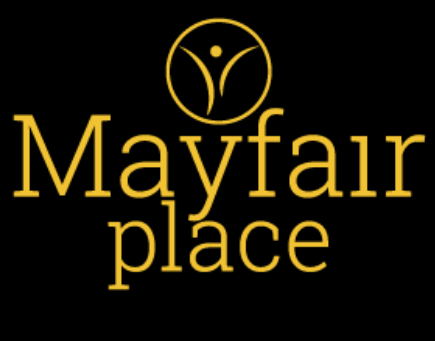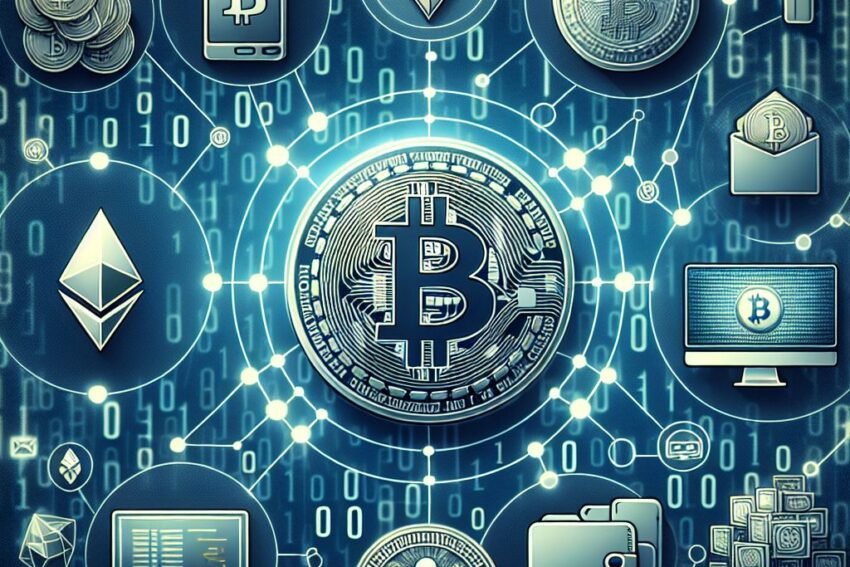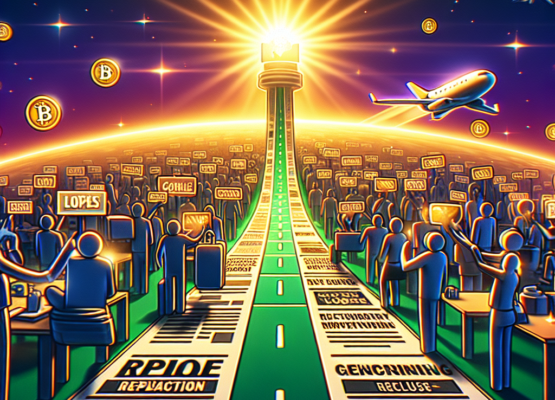Decentralized Finance, or DeFi, is revolutionizing money management. Control your assets without traditional banks using blockchain technology. Discover how to start and the benefits you’ll reap in the world of DeFi…
Imagine a world where you have complete control over your money, with no banks or middlemen telling you what you can and cannot do. That’s the promise of Decentralized Finance, or DeFi for short. It’s a new way of handling money that’s open to everyone, anywhere, anytime. Let’s dive in and see what all the fuss is about.
Key Takeaways:
- DeFi stands for Decentralized Finance, a technology that gives you control over your financial transactions without the need for traditional banks.
- It runs on blockchain technology, ensuring security, transparency, and accessibility.
- Getting started with DeFi is as simple as choosing a digital wallet and exploring smart contracts and DApps.
- DeFi offers many benefits, including financial inclusion, earning opportunities through yield farming and staking, and cutting out the middleman.
- However, it’s important to be aware of risks such as smart contract vulnerabilities and regulatory uncertainties.
Demystifying DeFi: The Future of Finance at Your Fingertips
When you hear the term DeFi, think of it as a big, open playground for financial activities, where the slides and swings are made up of software that everyone can inspect and trust. It’s built on the blockchain, the same tech that makes cryptocurrencies like Bitcoin possible. But instead of just sending and receiving coins, DeFi lets you do all sorts of financial stuff, like lending, borrowing, and earning interest.
What Makes DeFi Revolutionary?
DeFi changes the game by taking the power away from traditional financial institutions and giving it back to you. This means you get to be your own bank. And because it’s built on blockchain, every transaction is recorded on a public ledger, making it super transparent and tough to tamper with.
Exploring DeFi’s Core Technologies
The backbone of DeFi is blockchain technology, particularly Ethereum, which acts like a giant computer that the whole world can use together. It’s like a Lego set for finance, where developers build apps called DApps (Decentralized Applications) that anyone with an internet connection can use.
Getting Started with DeFi
So, you want to get your feet wet in the world of DeFi? Great! The first thing you’ll need is a digital wallet. This isn’t just any wallet; it’s a secure place to store your cryptocurrency and interact with DeFi applications.
The First Step: Choosing a DeFi Wallet
Choosing the right wallet is like picking out the best sneakers for a run—they’ve got to be comfortable and suit your needs. Here are a few popular options:
- MetaMask: A browser extension that’s super easy to use.
- Trust Wallet: A mobile app that keeps your crypto safe on the go.
- Argent: A wallet with extra security features and no fees for sending money.
Once you’ve got your wallet, load it up with some cryptocurrency, like Ethereum, because that’s the ticket to ride in the DeFi world.
Understanding Smart Contracts and DApps
Think of smart contracts as the robots of the blockchain. They automatically carry out transactions when certain conditions are met, no human involvement needed. These smart contracts are what power DApps, the apps you’ll use in DeFi.
DApps can do all sorts of things, from letting you swap different types of cryptocurrency to letting you lend out your crypto and earn interest on it. The best part? They’re open 24/7, and you don’t have to ask anyone’s permission to use them.
But let’s not just focus on the technical side. DeFi is about opening doors to financial services for everyone, including those who’ve been left out of the traditional banking system. It’s about creating a fairer world of finance.
Financial Inclusion for All
Imagine living in a place where the nearest bank is miles away, or where you can’t get a loan because you don’t have a credit history. DeFi leaps over these hurdles. With just a smartphone and an internet connection, you can access the same financial services as someone in the heart of New York City.
Most importantly, DeFi is designed to be inclusive. It doesn’t care who you are or where you’re from. All it sees is a wallet address that needs financial services. This is powerful. It’s not just about making money; it’s about making a difference.
Decentralization: Cutting Out the Middleman
Decentralization is the beating heart of DeFi. Instead of one company or organization calling the shots, DeFi spreads control across a whole network of computers. This means no one can deny your transaction or freeze your account. Your money, your rules.
Yield Farming and Staking: Earning Opportunities
Now, for the exciting part—making your crypto work for you. Yield farming and staking are two ways to earn passive income with your digital assets. Here’s how they work:
- Yield Farming: It’s like planting your crypto seeds and watching them grow. You lend your assets to others through a DeFi platform, and in return, you get fees and rewards.
- Staking: This is where you lock up your crypto to help secure a blockchain network. In exchange, you get new cryptocurrency as a reward. It’s like earning interest in a savings account.
But remember, with higher potential rewards come higher risks. It’s crucial to do your homework before diving in.
Navigating the Risks of DeFi
It’s not all rainbows and sunshine, though. DeFi is still pretty new, and that means it can be a bit like the Wild West. Let’s talk about some of the risks you need to watch out for in DeFi.
Smart Contract Vulnerabilities
Since DeFi is built on smart contracts, if there’s a bug in the contract code, things can go south quickly. Always check that the smart contracts you interact with have been audited by reputable security firms.
Regulatory Uncertainty Around DeFi
DeFi is on the cutting edge, and sometimes that means it’s ahead of the law. Governments are still figuring out how to regulate this space, which can lead to uncertainty. Make sure you stay up to date with the latest regulations in your area.
So, while DeFi opens up a world of opportunities, it’s important to tread carefully and make informed decisions. Always remember, if something sounds too good to be true, it probably is.
Real-World Applications of DeFi
Enough theory, let’s talk about how DeFi is being used in the real world. From borrowing and lending platforms to decentralized exchanges, DeFi is changing the way we think about money.
Peer-to-peer lending platforms allow you to lend your crypto to someone else and earn interest on it. And because it’s all done through smart contracts, you don’t have to worry about them running off with your money. It’s all locked up and automated.
Decentralized exchanges, or DEXs, let you trade cryptocurrencies without an intermediary. This means lower fees and more control over your trades. Plus, you don’t have to trust a centralized exchange with your funds.
There’s a lot more to DeFi than just this, but these examples give you a taste of its potential. It’s about taking the power back from institutions and putting it in your hands. And that’s just the beginning.
Real-World Applications of DeFi
Let’s get practical and explore how DeFi is being used today. It’s reshaping the financial landscape by offering solutions that traditional banking can’t match. With DeFi, we’re not just talking about potential; we’re seeing real change in action.
Peer-to-Peer Lending and Borrowing
One of the standout features of DeFi is peer-to-peer (P2P) lending and borrowing. This is where things get interesting because you can lend your crypto to others and earn interest, just like a savings account, but often with much higher rates. Borrowers, on the other hand, can get loans without the hassle of credit checks. It’s all based on the collateral they can provide, which in this case, is usually more crypto. Platforms like Aave and Compound are leading the way, making finance more accessible and profitable for users around the globe.
Here’s an example to illustrate how it works:
Sarah has 5 Ethereum (ETH) she wants to earn interest on. She uses a DeFi platform to lend her ETH to others. In return, she receives interest payments directly into her wallet, with rates that beat any traditional bank.
Decentralized Exchanges (DEXs) and Liquidity
Decentralized Exchanges, or DEXs, are another DeFi innovation that’s gaining traction. They’re like the stock market for cryptocurrencies, but without the middleman. On a DEX, you can swap your crypto directly with someone else’s, peer-to-peer, secure in the knowledge that smart contracts are handling the deal. Uniswap and SushiSwap are popular DEXs that also allow users to provide liquidity and earn a cut from transaction fees. It’s a win-win for everyone involved.
Building a Smarter Financial Future
DeFi isn’t just a fleeting trend; it’s laying the groundwork for a smarter, more inclusive financial future. By leveraging blockchain technology, DeFi is creating opportunities that were previously unimaginable.
But how does this all tie back to traditional finance? Well, the lines are starting to blur. Some traditional financial institutions are beginning to explore blockchain and even integrate DeFi concepts into their services. This could mean faster transactions, lower fees, and more access to financial services for people around the world.
DeFi and the Integration with Traditional Finance
The integration of DeFi with traditional finance is already underway. Banks and financial institutions are beginning to understand the value that blockchain and DeFi can bring to the table. We’re seeing collaborations that aim to bridge the gap between the old and new worlds of finance, bringing the benefits of DeFi’s efficiency and inclusivity to a broader audience.
For instance, Visa has started settling transactions in a stablecoin over the Ethereum blockchain, signaling a significant step towards mainstream acceptance of DeFi principles.
Innovation in DeFi: What’s on the Horizon?
The future of DeFi is bright and brimming with potential. Innovations continue to emerge at a rapid pace, driven by a community of developers committed to improving and expanding the ecosystem. From more sophisticated lending platforms to decentralized insurance protocols, the scope of DeFi is vast and varied.
One exciting development on the horizon is the concept of decentralized autonomous organizations (DAOs). These are organizations run by smart contracts that make decisions based on the votes of their members, rather than a central authority. It’s democracy and finance rolled into one, and it could change the way we think about organizations forever.
Finally, let’s wrap up with some actionable advice: for those interested in launching their own cryptocurrency or DeFi project, be sure to check out our comprehensive guide to crypto campaign success.
- If you’re new to DeFi, start small. Experiment with a small amount of money that you can afford to lose.
- Do your research. Not all DeFi projects are created equal, and it’s important to understand the risks involved.
- Stay informed. The world of DeFi moves fast, and staying up to date with the latest developments will help you make better decisions.
DeFi is more than just a buzzword; it’s a movement that’s empowering people financially across the globe. By understanding and participating in this space, you’re not just investing in your future; you’re helping to build a more open and fair financial system for everyone.
Option A.




